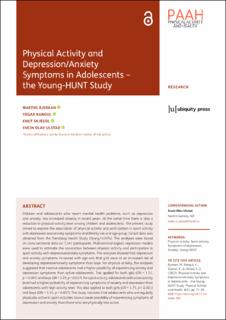Physical Activity and Depression/Anxiety Symptoms in Adolescents - the Young-HUNT Study
Peer reviewed, Journal article
Published version
Permanent lenke
https://hdl.handle.net/11250/3033895Utgivelsesdato
2022Metadata
Vis full innførselSamlinger
Originalversjon
Bjerkan, M., Rangul, V., Skjesol, K. & Ulstad, S. O. (2022). Physical Activity and Depression/Anxiety Symptoms in Adolescents - the Young-HUNT Study. Physical Activity and Health (PAAH), 6(1), 73-85. doi: 10.5334/paah.185Sammendrag
Children and adolescents who report mental health problems, such as depression and anxiety, has increased steadily in recent years. At the same time there is also a reduction in physical activity level among children and adolescents. The present study aimed to explore the association of physical activity and participation in sport activity with depression and anxiety symptoms stratified by sex and age group. Cohort data was obtained from the Trøndelag Health Study (Young-HUNT4). The analyses were based on cross-sectional data on 7,347 participants. Multinominal logistic regression models were used to estimate the association between physical activity and participation in sport activity with depressive/anxiety symptoms. The analyses showed that depression and anxiety symptoms increased with age and that girls were at an increased risk of developing depressive/anxiety symptoms than boys. For physical activity, the analyses suggested that inactive adolescents had a higher possibility of experiencing anxiety and depression symptoms than active adolescents. This applied for both girls (OR = 1.51, p < 0.001) and boys (OR = 1.29, p = 0.037). For sport activity, adolescents with a low activity level had a higher probability of experiencing symptoms of anxiety and depression than adolescents with high activity level. This also applied to both girls (OR = 1.75, p < 0.001) and boys (OR) = 1,55, p = 0.007). The study indicates that adolescents who are regularly physically active in sport activities have a lower possibility of experiencing symptoms of depression and anxiety than those who are physically less active.

